
William Ernest Powell Giles, best known as Ernest Giles, was an Australian explorer who led five major expeditions to parts of South Australia and Western Australia.
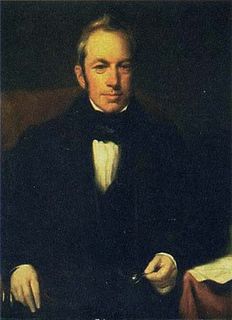
Robert Brown FRSE FRS FLS MWS was a Scottish botanist and paleobotanist who made important contributions to botany largely through his pioneering use of the microscope. His contributions include one of the earliest detailed descriptions of the cell nucleus and cytoplasmic streaming; the observation of Brownian motion; early work on plant pollination and fertilisation, including being the first to recognise the fundamental difference between gymnosperms and angiosperms; and some of the earliest studies in palynology. He also made numerous contributions to plant taxonomy, notably erecting a number of plant families that are still accepted today; and numerous Australian plant genera and species, the fruit of his exploration of that continent with Matthew Flinders.

Baron Sir Ferdinand Jacob Heinrich von Mueller, was a German-Australian physician, geographer, and most notably, a botanist. He was appointed government botanist for the then colony of Victoria by Governor Charles La Trobe in 1853, and later director of the Royal Botanic Gardens, Melbourne. He also founded the National Herbarium of Victoria. He named many Australian plants.

John Gilbert was an English naturalist and explorer. Gilbert is often cited in the earliest descriptions of many Australian animals, many of which were unrecorded in European literature, and some of these are named for him by those authors. Gilbert was sent to the newly founded Swan River Colony and made collections and notes on the unique birds and mammals of the surrounding region. He later joined expeditions to remote parts the country, continuing to make records and collections until he was killed during a violent altercation at Mitchell River (Queensland) on the Cape York Peninsula.

Jacques-Julien Houtou de Labillardière was a French biologist noted for his descriptions of the flora of Australia. Labillardière was a member of a voyage in search of the La Pérouse expedition. He published a popular account of his journey and produced the first Flora on the region.

Johann Wilhelm Theodor Ludwig von Blandowski, known as William Blandowski, was a German explorer, soldier, zoologist and mining engineer of Polish roots, he is most famous for his exploration of the Murray and Darling Rivers in Australia.
Desert exploration is the deliberate and scientific exploration of deserts, the arid regions of the earth. It is only incidentally concerned with the culture and livelihood of native desert dwellers. People have struggled to live in deserts and the surrounding semi-arid lands for millennia. Nomads have moved their flocks and herds to wherever grazing is available, and oases have provided opportunities for a more settled way of life. Many, such as the Bushmen in the Kalahari, the Aborigines in Australia and various Indigenous peoples of the Americas, were originally hunter-gatherers. Many trade routes have been forged across deserts, especially across the Sahara Desert, and traditionally were used by caravans of camels carrying salt, gold, ivory and other goods. Large numbers of slaves were also taken northwards across the Sahara. Today, some mineral extraction also takes place in deserts, and the uninterrupted sunlight gives potential for the capture of large quantities of solar energy.

William Harry Tietkens, known as "Harry Tietkens", explorer and naturalist, was born in England and emigrated to Australia in 1859. Tietkens was second in command to Ernest Giles on expeditions to Central Australia in 1873 and on a journey from Beltana, South Australia to Perth, Western Australia in 1875. In 1889 Tietkens led his own expedition west of Alice Springs to the vicinity of the Western Australian border. This expedition discovered Lake Macdonald, the Kintore Range, Mount Leisler, Mount Rennie, the Cleland Hills, defined the western borders of Lake Amadeus, and photographed Uluru and Kata Tjuta for the first time. The expedition collected new species of plants and rock samples allowing the South Australian government geologist to compile a 'geological sketch' of the country traversed. Tietkens was elected a fellow of the Royal Geographical Society on his return. Specimens of 250 plant species were collected, although only 8 were new to science, and in 1890, Ferdinand von Mueller and Ralph Tate named Eremophila tietkensii in his honour.
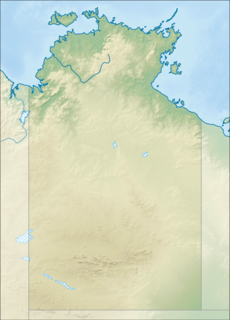
Charlotte Waters was a tiny settlement in the Northern Territory of Australia located close to the South Australian border, not far from Finke. It was known for its telegraph station, the Charlotte Waters Telegraph Station, which became a hub for scientists travelling in central Australia in the late 19th and early 20th century. Aboriginal artist Erlikilyika, known to Europeans as Jim Kite, lived there. Only a ruin remains today.
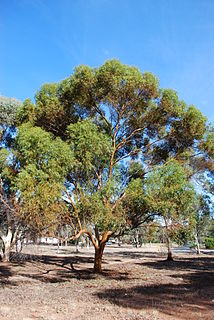
Eucalyptus salubris, commonly known as gimlet, fluted gum tree, gimlet gum and silver-topped gimlet, is a species of mallet that is endemic to low-rainfall areas of the wheatbelt and goldfields regions of Western Australia.

Eucalyptus youngiana, commonly known as large-fruited mallee, Ooldea mallee and yarldarlba, is a species of mallee, less commonly a tree, that in native to arid and semi-arid areas of southern Western Australia and South Australia. It has rough, fibrous bark on some or all of the trunk, smooth bark above, lance-shaped adult leaves, flower buds in groups of three, red, pink or bright yellow flowers and short, broad, conical fruit.

Livistona mariae, also known as the central Australian or red cabbage palm, is a species of flowering plant in the family Arecaceae.
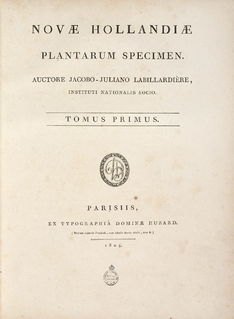
Novae Hollandiae Plantarum Specimen is a two-volume work describing the flora of Australia. Facsimiles of the originals can be found in the online Biodiversity Heritage Library (Vol.1) and Vol 2).
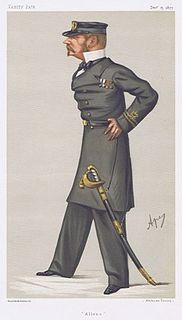
Sir Allen William Young, was an English master mariner and explorer, best remembered for his role in Arctic exploration including the search for Sir John Franklin.
Grevillea stenobotrya is a shrub in the family Proteaceae. It is endemic to arid regions of Australia. Common names include rattle-pod grevillea, sandhill grevillea and sandhill spider flower. Plants grow to between 1.5 and 6 metres in height and have leaves are linear and entire, or occasionally divided, and between 6 and 28 cm long and 0.7 to 2.5 mm wide. Flowers are cream, pale yellow or pale pink. These appear in clustered spikes at the end of branches between May and December in the species' native range. The fruits which follow are hard, flattened and rounded and have a short beak.

Alfred Giles, born in Datchet, England, was a South Australian bushman, drover and explorer who crossed Australia from south to north seven times, mostly in connection with the building of the Overland Telegraph Line 1870–1872.
The Mulford Biological Exploration of the Amazon Basin was a scientific expedition to the Amazon conducted in 1921. It was organized by Henry Hurd Rusby, who at age 64, was a well known explorer, a professor at Columbia University, and a staff member at the New York Botanical Garden. He hired Orland Emile White, a staff member at the Brooklyn Botanic Garden, to assist with collection and handling of plant specimens. The expedition was financed by the H. K. Mulford Company, a pharmaceutical company.

William Vincent Fitzgerald, was an Australian botanist. He described five genera and about 210 species of plants from Western Australia, including 33 Acacia and several Eucalyptus species. He also collected for other botanists such as Ferdinand von Mueller and Joseph Maiden and was known through his work on orchids. Eucalyptus fitzgeraldii was named for him by William Blakely.

Richard Thelwell Maurice was an explorer from South Australia who made eight or nine expeditions from his home base of Fowlers Bay, South Australia between 1897 and 1904.
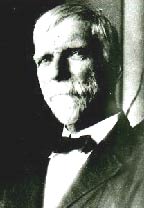
Robert Statham Williams was an American bryologist who specialized in the mosses of the Yukon and South America. The standard author abbreviation R.S.Williams is used to indicate this person as the author when citing a botanical name.

















